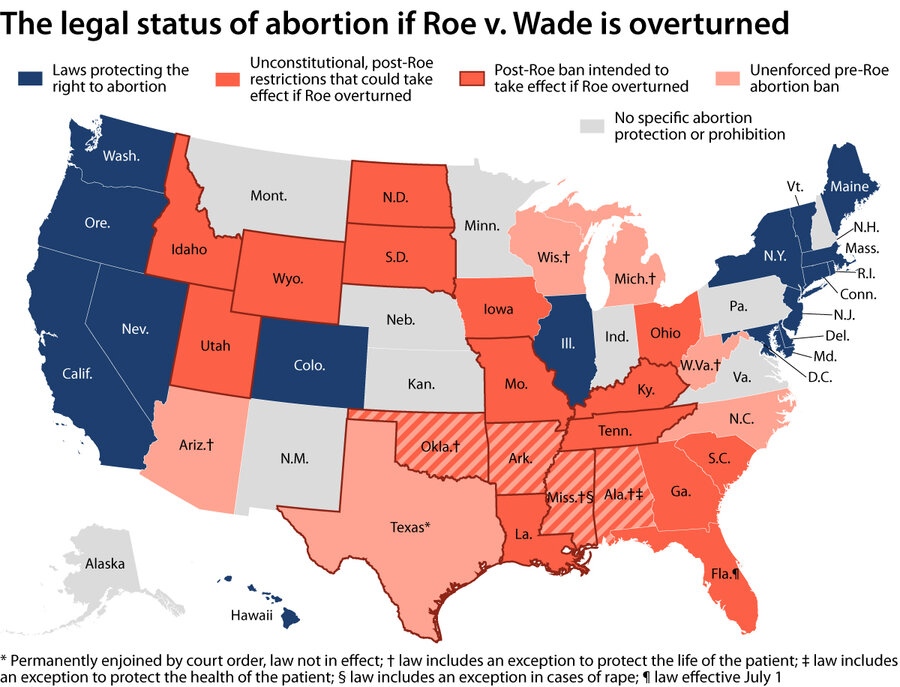Blue states want to create havens for abortion rights. Can they?
Loading...
| Los Angeles
Anticipating a country that no longer allows a constitutional right to an abortion – spurred on by a draft Supreme Court opinion that telegraphs this seismic change – blue states are strengthening their reproductive-rights laws. The move is not only to protect reproductive choice and care for women who reside in their states, but also to offer themselves as a “safe haven” for those who live in states where abortion is expected to be banned.
In Connecticut, the legislature passed a bill last month to shield providers and patients from lawsuits taken by states where abortion is illegal. In March, lawmakers in Oregon approved $15 million for expanded abortion access – in part to help with an influx of patients from neighboring Idaho. And in California, about a dozen reproductive-rights bills are working their way through the legislature, while the governor and lawmakers are promising to enshrine those rights in the state constitution.
“There’s real recognition that abortion rights are in jeopardy across a large part of the country, so progressive states are looking to see what they can do to make sure abortion remains available in their states, and not just for residents but for those coming to their states,” says Elizabeth Nash, who tracks state policies for the Guttmacher Institute.
Why We Wrote This
Both sides of the abortion debate say the end of Roe would be just “the beginning.” As California and others try to create havens for reproductive rights, the states may face legal warfare with one another.
Anticipating a country that no longer allows a constitutional right to an abortion – and spurred on by a draft Supreme Court opinion that telegraphs this seismic change – blue states are strengthening their reproductive-rights laws. The move is not only to protect reproductive choice and care for women and girls who reside in their states, but also to offer themselves as a “safe haven” for those who live in states where abortion is expected to be banned.
In Connecticut, the legislature passed a bill last month to shield providers and patients from lawsuits taken by states where abortion is illegal. In March, lawmakers in Oregon approved $15 million for expanded abortion access – in part to help with an influx of patients from neighboring Idaho, which has passed a six-week abortion ban. And in California, about a dozen reproductive-rights bills are working their way through the legislature, while the governor and lawmakers are promising to enshrine those rights in the state constitution.
“There’s real recognition that abortion rights are in jeopardy across a large part of the country, so progressive states are looking to see what they can do to make sure abortion remains available in their states, and not just for residents but for those coming to their states,” says Elizabeth Nash, who tracks state policies for the Guttmacher Institute, which researches and supports reproductive rights.
Why We Wrote This
Both sides of the abortion debate say the end of Roe would be just “the beginning.” As California and others try to create havens for reproductive rights, the states may face legal warfare with one another.
Access to abortion will be drastically changed in the United States if the Supreme Court overturns the landmark 1973 abortion-rights ruling in Roe v. Wade. That appears to be where the court is headed, as indicated in a draft majority opinion that landed with explosive political and cultural force in a leak to Politico this week. With that, decades of clashes leading up to the high court will be fought in and between the states, which would shape their own policies.
In a post-Roe world, 26 states are certain or likely to ban abortion – across the South, in the middle of the country, and in the West, according to Guttmacher. These states either have pre-Roe laws on the books or in their constitutions, have “trigger” laws that would take effect once Roe is overturned, or have already passed highly restrictive laws – including removing exemptions for rape or incest and making performing an abortion a felony. Women in those states have three options: to proceed with unwanted pregnancies, to self-induce abortions through medication or unsafe means, or to travel to sanctuary states.
“Access to medication abortion is vital” and accounts for more than 50% of U.S. abortions today, says Ms. Nash. Travel is expensive and stressful. For someone in Louisiana looking for abortion access, the nearest state would be Illinois, a 1,300-mile round trip, she says. Three-quarters of abortion patients have low incomes and the majority are already parents, so many would not be able to arrange for child care or afford to take time off from their jobs or get themselves to a far-off destination.
And yet travel is occurring. Patients from Texas, which enacted a six-week ban last year (before many women may know they are pregnant), are journeying to as far as Washington and Maryland – with an estimated 1,400 traveling every month since the ban took effect in September. Wait times at closer clinics in Colorado and Illinois can be three to four weeks.
“In states that maintain access, capacity will be stretched very thin,” says Ms. Nash. “You’re just seeing a total disruption in access to care. You can see why progressive states are shoring up protections for abortion.”
California to create a “template” for blue states
California has long been at the forefront of reproductive rights. In March, Gov. Gavin Newsom signed a bill that makes access to abortion more equitable by eliminating copays and deductibles from private health insurance and the state’s low-income Medicaid plan. The plans must cover the entire cost. He calls recommendations from a recently formed advisory council and the resulting slate of bills currently moving through the legislature a “template” for other states, casting California as a “beacon of hope.”
More than 160 clinics offer abortion in this deep-blue state, but even that is not enough, say abortion advocates. Some 40% of counties have no such clinics, and California is also dealing with an influx of patients from other states. The bills would help fill these gaps by expanding capacity – funding more training of health care workers and allowing nurse practitioners with proper training to perform first-trimester abortions. Grants would also go to organizations to help low-income patients – including those from out of state – and providers who are not compensated for their work with low-income patients.
Another category of bills would protect patients and providers from civil liability judgments based on laws in other states – and bolster privacy protections of abortion-related medical records from law enforcement and third parties seeking to enforce abortion bans in other states. Connecticut’s just-passed bills would prevent the governor from extraditing someone to another state if what they did in Connecticut is legal. In April, Colorado’s governor signed a law explicitly protecting abortion rights and blocking public entities from denying those rights. As of March, a Washington law forbids the state from taking legal action against people seeking an abortion and those who help them.
“Unsettled law”
This kind of legislating is a response to any Texas-style ban in which private citizens can sue anyone suspected of assisting with an abortion. Abortion advocates are also worried about a Missouri-like attempt to make it illegal for a resident to go out of state to seek an abortion. That effort in Missouri failed.
Such cross-border actions would open up a new front on the abortion battlefield, says Cary Franklin, a professor at the University of California, Los Angeles School of Law and an expert on reproductive rights and gender issues. She describes interstate-abortion legal action as “unsettled law” that has the potential to spawn many court cases.
“The irony is that [the Supreme Court’s] decision is going to create so much more controversy, and so much more confrontation, and so many more court cases,” she says. “The states are now going to be at war with one another.”
The ultimate way to protect abortion rights in a state, she and others say, is to anchor them in the state constitution. Although 16 states plus Washington, D.C., have codified reproduction rights in law, according to Guttmacher, future legislators can easily change such laws. Constitutions are much harder to change.
That’s why Democratic leaders in California, despite having a right to privacy in the state constitution that protects abortion, now want explicit constitutional protection. The overwhelming number of Democrats in the legislature means they could win the two-thirds required to amend the constitution, sending the amendment to voters in November. Last year, polling showed 79% of likely voters do not want Roe to be overturned.
“We know we can’t trust the Supreme Court to protect reproductive rights, so California will build a firewall around this right in our state constitution. Women will remain protected here,” the governor and legislative leaders said in a joint statement May 2. This fall, Vermont voters will also have an opportunity to vote on a constitutional change that protects abortion rights.
Even this, though, could still be vulnerable to a Supreme Court ruling, says Professor Franklin. If the court were to rule on fetal personhood – saying that a fetus has a constitutional right to life, as the anti-abortion movement argues – that would trump state constitutions, though it would depend on the wording, she says. “Fetal personhood is probably the end,” she says.
“Beginning” of a new phase
Abortion advocates and opponents describe a reversal of Roe as the “beginning” of a new phase in America’s painfully divisive and consequential debate.
“I think that this is not the end, but really just the end of the beginning of the pro-life movement,” says Jonathan Keller, president of the anti-abortion group California Family Council. The battleground will shift from the courthouse to statehouse, where state elections will “matter more than ever” as lawmakers shape reproductive policy.
He says it’s incumbent on voters who oppose abortion rights to back candidates who offer “real-world resources to women and families facing unwanted pregnancies.” That includes more funds for family resource centers, support for paid family leave, and better maternal care. “It’s going to give us a great opportunity to put our money where our mouth is.”
Susan Dunlap, president of Planned Parenthood Los Angeles, also thinks this moment is a start, not an end. “I believe it’s the beginning,” she says of the legislation moving through the statehouse in Sacramento. Planned Parenthood LA’s coordination within the state and county, and its collaboration with medical schools for training and UCLA Law for lawyers and research, as well as its reorganization to be near airports and bus and train stations – all of this has been to prepare for the beginning after the end of Roe.
This is an unprecedented moment, and “we don’t know what’s coming,” she explains, calling this the fight of a generation. As she told reporters at an appearance with the governor this week, what she does know is that Planned Parenthood will do all it can to keep its doors open, and take care of every woman who turns to it and other providers.
“We will lift up the values of liberty and freedom, knowing that we will not be defeated in this moment or in the long term, because freedom is the future and foundation of our country.”









